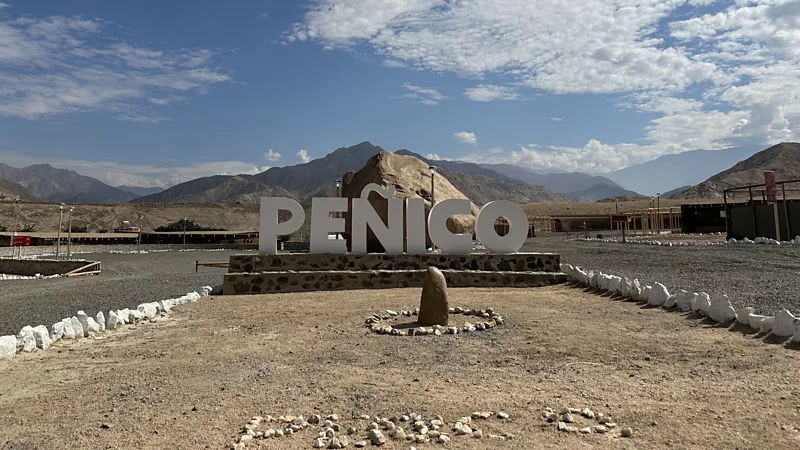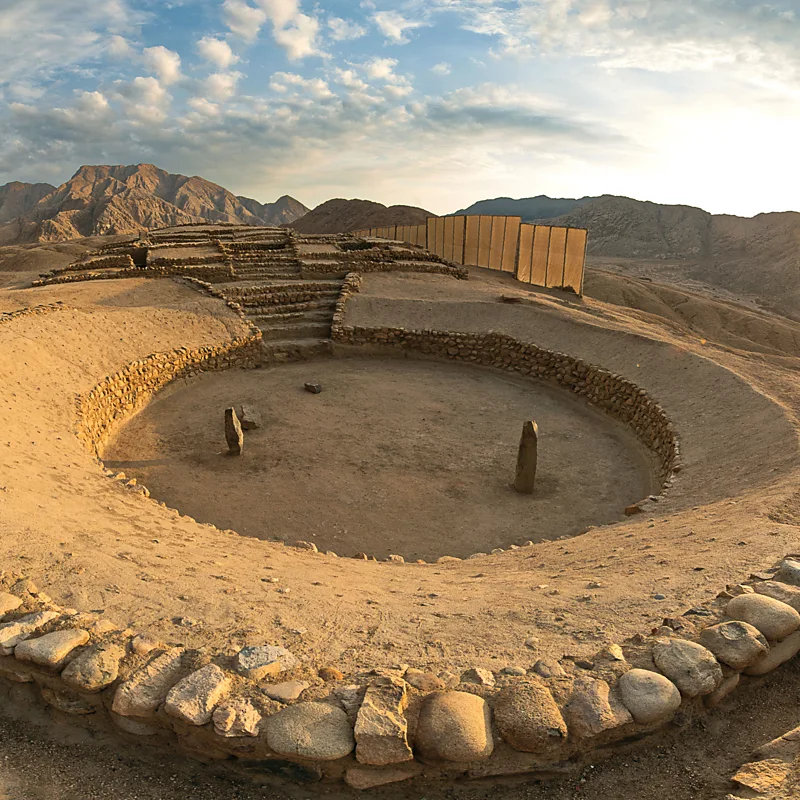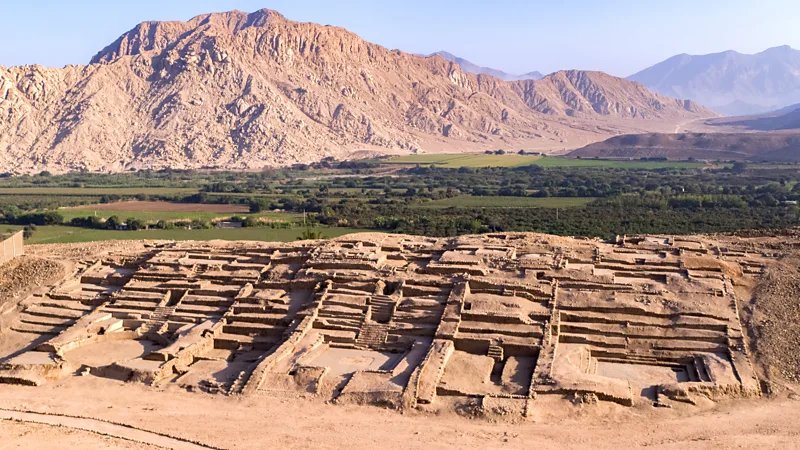Newly discovered desert city in Peru is rewriting what we know about the Americas’ earliest civilisation. Archaeologists have uncovered Peñico, a 3,800-year-old settlement of the Caral civilisation, revealing temples, plazas, and evidence of a peaceful adaptation to climate crisis.
The site, located on the windswept slopes of the Supe Valley, just four hours north of Lima, features 18 structures including ceremonial temples, plazas, and residential compounds. What makes this discovery extraordinary is the insight it provides into how early societies in the Americas adapted to climate disasters — and did so without resorting to war.
The Cradle of Civilisation in the Americas
Peñico is part of the Caral-Supe civilisation, one of the oldest urban societies in the world, flourishing around the same time as Mesopotamia and ancient Egypt. Caral-Supe has long been considered the cradle of civilisation in the Americas, dating from 3000 BCE to 1800 BCE, and is a UNESCO World Heritage Site.
Unlike many ancient societies, Caral was remarkable for its apparent lack of militarism. Archaeologists have found no defensive walls, no weapons, and no evidence of warfare in the area. Instead, Caral flourished through trade, music, ritual, and diplomacy, linking coastal fishing communities with highland agricultural settlements and even Amazonian tribes.
Discovery of Peñico: A Window into the Past
Dr. Ruth Shady, the Peruvian archaeologist who has led excavations in the Supe Valley for more than three decades, revealed Peñico in July 2025. The discovery sheds light on what happened to the Caral people after climate change triggered a severe 130-year drought that devastated their agricultural base.
Rather than collapsing into violence, the Caral seem to have adapted by relocating upriver, closer to glacial meltwater sources that still fed some parts of the valley. Peñico, built about 600 meters above sea level and just 10km from the main city of Caral-Supe, represents this adaptation strategy.

Peaceful Adaptation, Not Conflict
What makes Peñico truly unique is the evidence that the community faced environmental stress without turning to conflict. There are still no signs of weapons or fortified walls.
“This discovery confirms that the Caral people moved closer to reliable water sources and reorganized their society while maintaining peace,” Dr. Shady explains. “Peñico continues the Caral vision of life without conflicts.”
The find is significant because most ancient societies under similar duress turned to warfare or conquest to survive. Peñico shows us that collaboration and adaptation were possible even under extreme climate pressure — a lesson with modern relevance.
Architecture and Cultural Achievements
Archaeological digs have uncovered an array of ceremonial plazas, round courtyards, and multi-room residential compounds. These architectural designs suggest that Peñico retained the organisational sophistication of Caral-Supe, including consensus-based governance and planned urban layouts.
Artifacts discovered at the site include:
- Clay figurines and carved bones, some used in religious ceremonies
- Musical instruments, such as flutes and drums, used in rituals
- Necklaces and jewelry, indicating a continued tradition of artistry and cultural expression
One striking artifact is a sculpture of a woman’s head painted red with hematite pigment, revealing a highly developed symbolic and ceremonial culture.

Lessons from a 3,800-Year-Old Society
Peñico is not just a glimpse into the past — it is a mirror reflecting lessons for our own era. Climate change was the greatest challenge for the Caral people, just as it is for us today. Their response — relocation, cultural resilience, and collaboration — suggests that societies can survive environmental disasters without descending into violence.
“This is a powerful message for humanity,” says Shady. “We must learn to face climate change with cooperation and respect for nature, just as Peñico’s people did.”
Visiting Caral and Peñico Today
Both Caral and Peñico are open to visitors and can be reached by road from Lima.
- Opening Hours: 09:00 to 17:00 daily (last tour starts at 16:00)
- Tickets: Include entry to Caral’s on-site museum and nearby sites like Áspero and Vichama
- Guides: Local guides trained by Shady’s team offer rich insights into politics, astronomy, agriculture, and ritual life
Peñico’s new visitor center features exhibits that explain the Caral civilisation and the new findings. Its circular architecture mirrors the round plazas that are a defining feature of Caral and Peñico’s city planning.
Why This Discovery Matters
The discovery of Peñico is being called one of the most important archaeological finds of the decade. It not only fills a gap in our understanding of the Caral-Supe civilisation’s decline but also demonstrates how early societies coped with global climate shifts thousands of years ago.
For historians, it challenges the assumption that conflict is the default human response to crisis. For travelers, it provides a rare chance to explore a site that is still being actively excavated and interpreted.
As Gaspar Sihue, a local tour guide, puts it:
“I encourage people to come now while the sites are still quiet. It’s like stepping back in time to one of the first cities in the Americas.”
A Timely Reminder
Standing in Peñico today, surrounded by its plazas and ceremonial mounds, visitors are reminded that human resilience has always depended on ingenuity, cooperation, and respect for nature.
As Peru faces modern water shortages — having lost 56% of its tropical ice in the past six decades — Peñico’s story resonates more than ever. The survival of this society was not due to conquest, but to collaboration and a shared commitment to life.
Even partially buried beneath the desert sands, Peñico is giving humanity a message: survival depends on working together.
Source: BBC Travel – Peru’s New City Unearthed from the Desert
Archaeologists have announced the newly discovered desert city in Peru that could rewrite the history of the Americas. Known as Peñico, this 3,800-year-old settlement of the ancient Caral civilisation was revealed in July 2025 and has already been hailed as one of the most significant archaeological finds in recent decades.
The site, located on the windswept slopes of the Supe Valley, just four hours north of Lima, features 18 structures including ceremonial temples, plazas, and residential compounds. What makes this discovery extraordinary is the insight it provides into how early societies in the Americas adapted to climate disasters — and did so without resorting to war.
The Cradle of Civilisation in the Americas
Peñico is part of the Caral-Supe civilisation, one of the oldest urban societies in the world, flourishing around the same time as Mesopotamia and ancient Egypt. Caral-Supe has long been considered the cradle of civilisation in the Americas, dating from 3000 BCE to 1800 BCE, and is a UNESCO World Heritage Site.
Unlike many ancient societies, Caral was remarkable for its apparent lack of militarism. Archaeologists have found no defensive walls, no weapons, and no evidence of warfare in the area. Instead, Caral flourished through trade, music, ritual, and diplomacy, linking coastal fishing communities with highland agricultural settlements and even Amazonian tribes.
Discovery of Peñico: A Window into the Past
Dr. Ruth Shady, the Peruvian archaeologist who has led excavations in the Supe Valley for more than three decades, revealed Peñico in July 2025. The discovery sheds light on what happened to the Caral people after climate change triggered a severe 130-year drought that devastated their agricultural base.
Rather than collapsing into violence, the Caral seem to have adapted by relocating upriver, closer to glacial meltwater sources that still fed some parts of the valley. Peñico, built about 600 meters above sea level and just 10km from the main city of Caral-Supe, represents this adaptation strategy.
Peaceful Adaptation, Not Conflict
What makes Peñico truly unique is the evidence that the community faced environmental stress without turning to conflict. There are still no signs of weapons or fortified walls.
“This discovery confirms that the Caral people moved closer to reliable water sources and reorganized their society while maintaining peace,” Dr. Shady explains. “Peñico continues the Caral vision of life without conflicts.”
The find is significant because most ancient societies under similar duress turned to warfare or conquest to survive. Peñico shows us that collaboration and adaptation were possible even under extreme climate pressure — a lesson with modern relevance.
Architecture and Cultural Achievements
Archaeological digs have uncovered an array of ceremonial plazas, round courtyards, and multi-room residential compounds. These architectural designs suggest that Peñico retained the organisational sophistication of Caral-Supe, including consensus-based governance and planned urban layouts.
Artifacts discovered at the site include:
- Clay figurines and carved bones, some used in religious ceremonies
- Musical instruments, such as flutes and drums, used in rituals
- Necklaces and jewelry, indicating a continued tradition of artistry and cultural expression
One striking artifact is a sculpture of a woman’s head painted red with hematite pigment, revealing a highly developed symbolic and ceremonial culture.
Lessons from a 3,800-Year-Old Society
Peñico is not just a glimpse into the past — it is a mirror reflecting lessons for our own era. Climate change was the greatest challenge for the Caral people, just as it is for us today. Their response — relocation, cultural resilience, and collaboration — suggests that societies can survive environmental disasters without descending into violence.
“This is a powerful message for humanity,” says Shady. “We must learn to face climate change with cooperation and respect for nature, just as Peñico’s people did.”
Visiting Caral and Peñico Today
Both Caral and Peñico are open to visitors and can be reached by road from Lima.
- Opening Hours: 09:00 to 17:00 daily (last tour starts at 16:00)
- Tickets: Include entry to Caral’s on-site museum and nearby sites like Áspero and Vichama
- Guides: Local guides trained by Shady’s team offer rich insights into politics, astronomy, agriculture, and ritual life
Peñico’s new visitor center features exhibits that explain the Caral civilisation and the new findings. Its circular architecture mirrors the round plazas that are a defining feature of Caral and Peñico’s city planning.
Why This Discovery Matters
The discovery of Peñico is being called one of the most important archaeological finds of the decade. It not only fills a gap in our understanding of the Caral-Supe civilisation’s decline but also demonstrates how early societies coped with global climate shifts thousands of years ago.
For historians, it challenges the assumption that conflict is the default human response to crisis. For travelers, it provides a rare chance to explore a site that is still being actively excavated and interpreted.
As Gaspar Sihue, a local tour guide, puts it:
“I encourage people to come now while the sites are still quiet. It’s like stepping back in time to one of the first cities in the Americas.”
A Timely Reminder
Standing in Peñico today, surrounded by its plazas and ceremonial mounds, visitors are reminded that human resilience has always depended on ingenuity, cooperation, and respect for nature.
As Peru faces modern water shortages — having lost 56% of its tropical ice in the past six decades — Peñico’s story resonates more than ever. The survival of this society was not due to conquest, but to collaboration and a shared commitment to life.
Even partially buried beneath the desert sands, Peñico is giving humanity a message: survival depends on working together.
Source: BBC Travel


